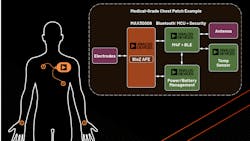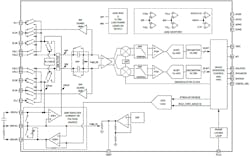High-Functionality, Ultra-Low-Power AFE Advances Remote Patient Monitoring
Personalized medical monitoring is clearly a hot and important area for many reasons—and doing it remotely and continually is even hotter. Key to accomplishing this successfully at the physical and sensor level, which is where such desired biomedical “insight” and data-capture starts by necessity, is the ability to monitor body bioimpedance (often simply referred to BioZ). A lot can be ascertained with such non-invasive skin-based sensing, until humans evolve to come “pre-wired” with suitable sensors and an interface (presumably wireless but perhaps as an implant, who knows?),
Addressing the challenging needs of this application, Analog Devices/Maxim introduced the MAX30009, a high-functionality, highly sophisticated, ultra-low-power BioZ analog front end (AFE) for remote-patient monitoring (RPM) devices (obviously, this designation “RPM” should not be confused with revolutions per minute!) (Fig. 1).
Bioimpedance-based analysis devices offer a convenient way for healthcare professionals to measure or assess parameters such as body fat percentage and body composition, respiration, and impedance cardiography. However, from a sensor standpoint, it’s a difficult environment due to millivolt signals of random signal strength originating from high-impedance sources that can’t tolerate low-impedance loading from the front-end amplifiers. In fact, AFE input impedances above 1 GΩ are needed.
AFE-on-a-Chip
Focused on developers of small, battery-powered, continuously wearable devices, this AFE-on-a-chip offers clinical-grade vital-sign measurements of bioimpedance analysis for patient health assessment. It suits wellness wearables and medical-grade patches and requires just 250 μW of power from a 1.8-V battery. Typical shutdown current is just 0.6 μA.
The MAX30009 monitors a comprehensive range of BioZ modalities through simultaneous I and Q measurements in two-electrode (bipolar) and four-electrode (tetrapolar) configurations. Analog Devices maintains that this device reduces power consumption by 62% compared to the closest competitive product and is 30% smaller than the closest competitor.
BioZ Measurements
As a result, flexible inputs for BioZ modality measurements as well as a wide range of sample rates can support various medical BioZ measurements. Such a wider range allows for more detailed insights into patient health by measuring respiration rate, galvanic skin response and electrodermal activity, body composition and fluid analysis, bioimpedance spectroscopy, impedance cardiography, and plethysmography across a wide range of frequencies and magnitudes.
Despite the apparently low operating frequency of the human body, the IC’s medical-requisite frequency range is actually quite wide. The various types of stimuli can operate over frequencies from 16 Hz to 806 kHz, with stimui rates from a mere 16 samples/s to 806 ksamples/s (Fig. 2). The sigma-delta analog-to-digital converter (ADC) offers 20-bit ADC resolution.
The full functionality and feature set of this IC are too lengthy, complicated, and multifaceted to be summarized here in a paragraph, even a long one. Fortunately, the first page of the comprehensive 96-page datasheet provides an excellent overview and summary.
Eval Kit
The MAX30009 uses an SPI interface to its companion microcontroller and is housed in a 2.03- × 2.03-mm, 25-bump, wafer-level package (WLP). Hands-on development support is available using the MAX30009EVKIT# Evaluation Kit (Fig. 3).
This kit consists of two boards: a microcontroller board plus a sensor board containing the MAX30009 itself. It’s powered by a 105-mAh LiPo battery that’s recharged through a supplied USB-C cable; it transfers data using the included Cypress USB Bluetooth LE dongle. Six electrode cables also are included along with other cables.
The board, which includes many easy-to-reach test points, can be observed and controlled via the available Windows 10 GUI. Its detailed 29-page datasheet/user guide includes necessary operating details, state diagrams, timing diagrams, and flow charts plus a schematic diagram and full bill of materials (BOM).
There’s also an informative video that looks at the medical objectives and challenges, and explains the role of this IC in that context. It’s linked at the bottom of the MAX30009 product page. The MAX30009 is priced at $5.26 (1,000-piece lots), while the complementary MAX30009EVKIT# Evaluation Kit goes for $198.22.
About the Author

Bill Schweber
Contributing Editor
Bill Schweber is an electronics engineer who has written three textbooks on electronic communications systems, as well as hundreds of technical articles, opinion columns, and product features. In past roles, he worked as a technical website manager for multiple topic-specific sites for EE Times, as well as both the Executive Editor and Analog Editor at EDN.
At Analog Devices Inc., Bill was in marketing communications (public relations). As a result, he has been on both sides of the technical PR function, presenting company products, stories, and messages to the media and also as the recipient of these.
Prior to the MarCom role at Analog, Bill was associate editor of their respected technical journal and worked in their product marketing and applications engineering groups. Before those roles, he was at Instron Corp., doing hands-on analog- and power-circuit design and systems integration for materials-testing machine controls.
Bill has an MSEE (Univ. of Mass) and BSEE (Columbia Univ.), is a Registered Professional Engineer, and holds an Advanced Class amateur radio license. He has also planned, written, and presented online courses on a variety of engineering topics, including MOSFET basics, ADC selection, and driving LEDs.



